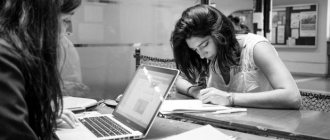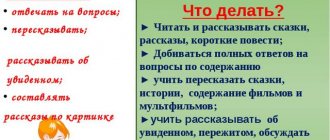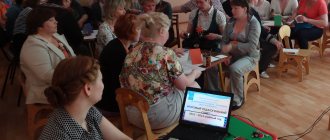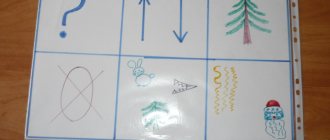When teachers begin to use innovative technologies in their work, as such visual techniques are already called, this makes it possible to balance the capabilities of all children. Due to their individual characteristics, children even of the same age develop differently and master the skills of using a brush, pencil, and paints in different ways. Sometimes a child is afraid that he will not be able to paint with a brush what he would like and may gradually lose interest in fine art. This does not happen if, along with the basic visual technologies, there are visual techniques of a slightly different type, requiring other skills, and sometimes allowing a completely unprepared child to create his own small work of art.
Quite often it happens that the most interesting from an artistic point of view are the works of those children for whom ordinary art classes are not easy. It is the opportunity to experiment, explore, try without fear of making mistakes that allows such children to reveal their artistic and creative potential.
Main tasks solved with the help of innovative technologies.
1.Development of children’s creative abilities, aesthetic perception of the surrounding reality. 2.Development of interest in experimenting with materials and means of representation. 3.Development of the ability to independently select materials, taking into account their inherent artistic properties, to choose means that correspond to the artistic concept.
The use of non-traditional technologies does not exclude the main tasks that the teacher sets for himself when conducting art classes.
“Using effective methods and techniques for teaching preschoolers to draw”
Tatiana Markova
“Using effective methods and techniques for teaching preschoolers to draw”
Topic: “ Using effective methods and techniques
teaching preschoolers to draw»
1. Introduction:
Mastering visual activities in kindergarten is of great importance for a child: a preschooler gets the opportunity to independently create a drawing, create a positive emotional mood, and contributes to the development of creativity, aesthetic sense, imaginative ideas and imagination. Drawing is perhaps the most interesting activity for preschool . Visual activity allows children to express in drawings their idea of the world around them, their understanding of it and their attitude towards it. Drawing for a child is a unique form of knowledge of reality, the surrounding world, comprehension of artistic art, and therefore requires in-depth study, prediction and correction of children's education .
Children's creativity is based on imitation, which serves as an important factor in the development of the child, in particular his artistic abilities. The teacher’s task is, based on children’s tendency to imitate, to instill in them the skills and abilities without which creative activity is impossible, to cultivate in them independence, activity in the application of this knowledge and skills, to form critical thinking and focus.
It is known that children's creativity is a unique phenomenon. Many teachers and psychologists, both domestic and foreign, emphasize the great importance of artistic creativity in the all-round, especially in the aesthetic development of the child’s personality. Visual activity plays a big role in nurturing the aesthetic feelings of a preschooler . drawing classes provides ample opportunities for experiencing beauty and for developing children’s emotional and aesthetic attitude to reality. Fine art shows a person the world of real-life beauty, shapes his beliefs, and influences his behavior. It is very important when explaining the task to specifically reveal the aesthetic content of the image object. Moreover, the teacher must talk about the elements of beauty in an object or phenomenon in an emotional, expressive form. If the teacher, having placed “brightly colored objects” as the subject for the drawing, analyzes them in an ordinary, even voice and does not find words expressing the brightness, colorfulness, unusualness of nature, then the children’s emotions will be affected, the eyes will calmly begin to “color”
their drawings, without showing much interest in the depicted and their work. To consolidate moral feelings, deepen aesthetic
experiences, it is necessary to create a certain emotional mood during the lesson. A child develops a creative approach to solving any problem only if the teacher introduces him to many ways and options for solving it. The choice of one or another technique when creating an image is determined by the ability to observe, peer into the surroundings, noticing not only bright, eye-catching details, but also nuances. It is not enough to teach children craft skills and techniques for working with various artistic materials, the main thing is to awaken in them feelings and a personal attitude towards the planned work.
The teacher’s personal example, help, demonstration, and explanation have a huge impact on the development of a child’s artistic abilities. In the visual activities of children, their creative abilities develop, which is one of the important tasks of aesthetic education.
The visual activities of preschoolers contain great potential for the comprehensive development of the child. However, these opportunities can only be realized when children feel joy and satisfaction from what they have created, if the creative process puts them in a good mood.
2. RELEVANCE
In teaching fine arts, two main approaches have long competed, which can be defined as academic teaching and free education. In the first case, children are taught to depict objects in accordance with the requirements of realistic fine art. With such a system of education , children can acquire some skills that are useful in many specialties and everyday situations, but they do not gain experience in solving artistic problems and do not become familiar with art. This is learning without creativity .
In the second case, a favorable environment for creativity is created for children without providing targeted pedagogical influence. They gain the experience of free self-expression, communication with artistic materials, etc. But this is creativity without training . It rises on the wave of “age-related talent,” as if apart from the child himself, and with it fades away. The little artist does not “take control” of his own creative potential. A third way is needed—the path of purposeful guidance of children’s creative development. The first thing to think about is that the child is a creative subject. It must be taken into account that no one except the child himself will give the “correct” solution to the creative problem facing him (for example, if a child is looking for a combination of colors that expresses a certain feeling, he is solving a truly artistic problem).
In accordance with the purpose of the study, I solved the following problems:
1. Studying methods of teaching drawing to preschoolers
2. Consideration of the features of the content of teaching children to draw
3. Description of non-traditional drawing techniques for preschoolers ;
4. Analysis of the features of planning lessons in teaching drawing
5. Development of lesson notes on visual arts using non-traditional techniques.
The subject of the study is the visual activity of preschool children .
The object of study is unconventional drawing techniques .
In the process of preliminary work on the topic, I formulated a research hypothesis: non-traditional methods of teaching drawing in combination with traditional teaching methods help to reveal the child’s creative potential
The theoretical basis of the research is the work on methods of teaching preschoolers visual arts by such authors as O. N. Zelenova, N. V. Shaidurova, G. N. Davydova, I. A. Lykova, M. G. Smirnova, Yu. V. Ruzanova.
The methodological basis of the research consists of methods of analysis , systematization of acquired knowledge, and description of phenomena.
The practical significance of the study lies in the development of a methodology for developing the creative personality of preschool children in drawing classes . The results obtained can be used when teaching preschoolers how to draw in a kindergarten, as well as in group work.
3. Methods and techniques for teaching preschoolers art activities
Many years of experience in teaching work shows that the lack of necessary visual skills in children often leads to the triviality and inexpressiveness of children's works, since not knowing certain methods of depiction, children exclude from their drawing those images that are draw . In order for a child to draw with pleasure and improve his creativity, an adult must help him in a timely manner. The success of training depends on the correct definition of its goals and content, as well as on the ways to achieve the goals, that is, teaching methods . Success largely depends on what methods and techniques the teacher uses to convey certain content to children, to develop their knowledge, skills and abilities. We adhere to the modern classification of methods , the authors of which are Lerner I. Ya., Skatkin M. N. It includes the following teaching methods :
• information-receptive;
• reproductive;
• research;
• heuristic;
• method of problematic presentation of material.
The information-receptive method includes the following techniques :
• examination;
• observation;
• excursion;
• example of a teacher;
• showing the teacher.
The reproductive method is a method aimed at consolidating the knowledge and skills of children. This is a method of exercise that brings skills to automaticity. It includes:
• retry reception;
• work on drafts;
• performing form-building movements with the hand.
The heuristic method is aimed at demonstrating independence at some point in the work during the lesson, that is, the teacher invites the child to do part of the work independently.
The research method is aimed at developing in children not only independence, but also imagination and creativity. The teacher offers to do not just any part, but all the work independently.
The method of problem presentation cannot be used in teaching preschoolers and primary schoolchildren: it is applicable only for older schoolchildren.
All modern forms of education see as their goal increasing interest in cognitive activity and learning , and this will contribute to a more effective and efficient educational process. Therefore, the main pedagogical teaching methods include :
• freedom of choice (in any learning activity of the student there is the right to choose)
;
• openness (not just teach, but pose problems to students, the solution of which goes beyond the scope of the material being studied);
• activity (involves the application of knowledge in practice)
;
• high productivity ( the knowledge and capabilities of students should be used to the maximum, taking into account their interests);
• feedback (it is necessary to constantly keep the learning using feedback techniques ).
The effectiveness of methods depends on the pedagogical conditions of their application.
In many ways, the result of a child’s work depends on his interest, so during the lesson it is important to intensify the preschooler’s ,
motivate him to activity with the help of additional incentives. Such incentives can be:
• play, which is one of the main activities of children;
• a surprise moment - a favorite fairy tale or cartoon character comes to visit and invites the child to go on a trip;
• asking for help, because children will never refuse to help the weak, it is important for them to feel significant;
• musical accompaniment. Etc.
In addition, it is advisable to vividly and emotionally explain to the children the methods of action and show depiction techniques . The characteristics of preschool age necessitate the need to reinforce any productive activity with words, plastic movements, playback, etc. Without this, it is difficult for a child to reveal the intended image. Due to his age, the child easily transforms, communicates actively, and joins the game with interest. The game occupies a leading place in the organization of children's activities. Therefore, classes with preschoolers should be filled with games of various types, from didactic to role-playing.
Great importance is given to the word in the development of visual activity of preschool children . It is with a word that it is necessary not only to describe the appearance of an object, but also to characterize its features. To do this, you can widely use dramatization games , riddle evenings, organizing exhibitions in the classroom, including excursions; educational stories, etc.
Thus, in the process of teaching preschoolers visual arts, it is advisable to use the following methods and techniques :
1. Emotional mood
This method involves the use of musical works in the classroom. It must be remembered that musical images and musical language must be appropriate to the age of the children.
During classes, music puts children in the same mood: it calms the excited ones, mobilizes the inhibited ones, and activates the children’s attention. Music can also accompany the process of visual creativity in the classroom.
2. Artistic word
How many points of contact can be found between words and fine art! They complement each other, activating the artistic perception of the image. Children respond especially emotionally to the beauty of poetic lines; they help preschoolers understand their feelings before picking up a brush and paint.
3. Pedagogical dramaturgy
During classes, children often travel. Travel can be real, fabulous or imaginary. For younger preschoolers , this is a trip to the Land of Drawing . An entertaining fairy tale plot, unconventional drawing - all this helps develop children's emotions and imagination.
For older preschoolers, the method of creative visualization is used. Children sit comfortably on the carpet, relax, close their eyes, listen to the sounds of the forest, river, and the sound of the sea. The calm, warm voice of the teacher helps to imagine a picture of nature, which the children will then embody in their drawings.
Children can also travel to real places - to an artist’s studio, to an exhibition hall, to take excursions around the city, to a forest or field. During these trips, children come into direct contact with the world of art and meet true masters. Everything - be it nature, a hall or the street - becomes a teacher of Beauty for a child: the human artist and the nature artist help the teacher and awaken the children’s feelings.
4. Plastic surgery
Preschoolers have a natural grace and freedom of body. Sometimes it seems that they express all their thoughts and experiences through movement. Initially, the child receives almost all information about the environment through bodily sensations, therefore, in different parts of the body there are zones that “remember” the positive and negative imprints of his communication with the world. And it is very important during the development of a child to try to avoid psychological clamps in the body that form as a result of negative experiences.
movement actively used in visual activities . Exercises such as “Flower Dance”, “Air Ball”, “Fun Zoo”, “Sea” not only develop plasticity, they are aimed at making the child feel freedom and emotional self-expression.
5. Theater
Elements of theater are organically included in arts activities and contribute to the development of feelings in children. There are no memorized roles, positions, gestures - everything is based on the emotional experience of children, on the embodiment of their experiences.
The younger group uses elements of shadow theater. The image is devoid of details; the child highlights only the main, characteristic features of his hero. Older children themselves can, through lines, color, and by selecting artistic means, convey the character of a fairy-tale hero - the evil Baba Yaga or the valiant hero-defender.
Children of the preparatory group continue to get acquainted with theatrical art. Now the children themselves play the chosen characters, having previously made a mask - a laconic but vivid way of conveying the character and mood of the hero.
6. Game
One of the most important methods for developing a child’s inner world is play. V. A. Sukhomlinsky wrote: “A game is a huge bright window through which a life-giving stream of ideas and concepts about the surrounding world flows into the spiritual world of a child.”
Play is an essential method for developing children's imagination and cognitive abilities. In the game, it is easy to direct the child’s attention to the most important guidelines - moral, aesthetic.
games are used in art classes :
artistic and educational - “The Good and the Evil Wizards”, “Palette”
didactic - “Complete the fairy tale”, “Collect a landscape”, “Seasons”
graphic - “Pantomimetics”, “ Drawing by points ”, “Symmetry”, etc.
It is extremely important from the very first steps to cultivate in children a sustainable interest in visual arts, which helps develop perseverance, ability to work, and perseverance in achieving results. This interest is initially involuntary and is aimed at the process of the action itself. The teacher gradually carries out the task of developing interest in the result, in the product of the activity. This product is a drawing, visual and thereby attracts the child to itself, attracts his attention.
Gradually, children become more and more interested in the results of their work, the quality of its implementation, and not only experience pleasure in the drawing .
Children of six or seven years old, who are on the threshold of school, have new motives for their interest in classes—a conscious desire to learn how to draw . There is an increasing interest in the process of doing work according to the instructions of the teacher in order to get a good result. There is a desire to correct and improve your work.
4. TECHNOLOGY
Teaching preschoolers drawing techniques
In the visual arts, under technique (from the Greek skillful and art, skill)
refers to a set of special skills, methods and
techniques by which is performed .
The concept of technology in the narrow sense of the word usually corresponds to the direct, immediate result of the artist’s work with a special material and tool (hence the technique of oil painting, watercolor, gouache, tempera, etc., the ability to use the artistic capabilities of this material; in a broader sense, this concept covers corresponding elements of a pictorial nature - conveying the materiality of objects .
Thus, drawing technique should be understood as: mastery of materials and tools, ways of using for the purposes of depiction and artistic expression. The concept of technology includes the development of the eye and hand, their coordinated activity. Particular importance is attached to skillful, correct depiction of the contour and shape of the object. Drawing in kindergarten is aimed at teaching artistic and creative activities within the limits accessible to preschool .
We want to teach children drawing so that they can freely use it when solving any visual task, and most fully express their impressions of the life around them in a drawing. In kindergarten, it is necessary to immediately, within accessible limits, formulate the correct drawing technique for all children , so that later they do not have to be retrained.
The definition of drawing technique that is accepted in the fine arts is mainly applicable to the technique of children's drawing. The difference lies in the fact that in a preschool there is an initial development of the varied and subtle movements of the hand that are necessary for drawing , and which can be called drawing movements . Mastering a contour line, a stroke, a spot as expressive means of drawing constitutes a special task for a small child, which the child cannot solve on his own.
Analyzing the various social functions of drawing and identifying the two main ones among all - pictorial and expressive, N.P. Sakkulina accordingly distinguishes two groups of abilities for visual activity: the ability to depict and the ability to artistic expression.
Image ability consists of three components:
1. Perception and related representation.
To learn to depict, you need to master a special way of perception: to see the object as a whole (perceive the content and form in unity, and the form - at the same time dismembered (structure, color, position in space, relative size)
.
2. Mastery of the means of graphic embodiment of an image (mastery of a complex of skills and abilities of image, form, structure, proportional relationships, position in space).
Without mastering these graphic skills and abilities, the ability to depict cannot be formed.
3. Mastery of drawing techniques.
Technical skills and abilities are closely fused with graphic ones and are their integral part. However, N.P. Sakkulina distinguishes them into a separate group due to their specificity and subordination to the main ones - graphic.
Later, T. S. Komarova noted manual skill as a unique complex sensory ability that can and should be formed in preschool age . The structure of this ability includes three components:
drawing technique (methods of correctly holding a pencil, brush and mastering rational techniques for using them , mastering the technique of line, stroke, spot);
• shaping movements (movements aimed at conveying the shape of an object)
and regulation of
drawing movements according to a number of qualities (tempo, rhythm, amplitude, pressure force, smoothness of movement, continuity;
• maintaining the direction of movement in a straight line, arc, circle, the ability to change the direction of movement at an angle, the transition from movement in a straight line to movement in an arc and on the contrary, the ability to subordinate movement to the proportionality of segments in length, images or their parts in size
Having developed a detailed method for developing this complex ability in children, T. S. Komarova considers it as a means by which a child will be able to expressively and without much difficulty create any image or express any idea. Children of middle preschool age are able to describe objects, highlighting their color and shape, size, and spatial arrangement of parts; use different color combinations; paint over drawings; correctly convey the structure of an object, the arrangement of parts when depicting complex objects ; depict several objects .
Children of older preschool age know how to mix paints; draw from an idea from life, conveying the shape, proportions, color of objects ; convey various subjects: scenes from life, animal movements, situations from fairy tales.
Non-traditional artistic techniques
Today there is a choice of options for art preschool education , and it is determined by the presence of variable, additional, alternative, author's program and methodological materials , which are not sufficiently scientifically substantiated and require theoretical and experimental testing in the specific conditions of preschool educational institutions.
When doing algorithmic drawing, the teacher suggests mentally dividing an object into its components - body, neck, head, tail - comparing them with geometric shapes and drawing in a certain sequence, observing proportions. This kind of work is called algorithmic drawing . The availability of non-traditional techniques is determined by the age characteristics of preschool children . So, for example, you should start working in this direction with techniques such as drawing with your fingers , palm , tearing paper, etc., but in older preschool age these same techniques will complement the artistic image created using more complex ones: blotography, monotype and etc.
Methodology for working with operational (technological) maps.
Operational cards allow the teacher to clearly and clearly introduce children to a new way of drawing; help children analyze what materials will be needed to perform work using a particular technique; what sequence of operations needs to be performed to achieve the desired result.
After the children have become familiar with the new technique, the operation card is placed in the center of the art. Children use it in independent activities to remember how to work with this technique. Gradually, as they become acquainted with other innovative technologies, a selection of cards is collected in the center, which allows the child to independently make a choice of techniques and materials in accordance with his idea.
Non-traditional drawing techniques for preschool children
Consultation for parents “Non-traditional drawing techniques in joint activities of children and parents”
Unconventional drawing techniques in the joint activities of children and parents
Author: Toporkova Natalya Yuryevna The artist wants to draw, Let them not give him a notebook... That’s why the artist and the artist - He draws wherever he can... He draws with a stick on the ground, In winter, with his finger on the glass, and writes charcoal on the fence, and on the wallpaper in the hallway. He draws with chalk on a board, writes on clay and sand, even if there is no paper at hand, and no money for canvases, he will draw on stone, and on a piece of birch bark. He will paint the air with fireworks, Taking a pitchfork, he writes on the water, An artist, because he is an artist, Because he can draw everywhere. And whoever interferes with the artist deprives the earth of its beauty! “The origins of children’s abilities and talents are at their fingertips.
From the fingers, figuratively speaking, come the finest threads - streams that feed the source of creative thought. In other words, the more skill in a child’s hand, the smarter the child.” V.A. Sukhomlinsky It is known that drawing is one of the most favorite children’s activities, which develops in a child many positive qualities, such as perseverance and patience, attentiveness, imagination, ability to think and much more.
All of them will be very useful to the baby in later life. Along with traditional methods of depicting an object or object on paper (drawing with pencils, brushes and paints, gouache), I also use non-traditional techniques in my work. I think that they attract the attention of little fidgets more. They are interesting to children of all ages and allow them to reach their full potential during the creative process. The work of creating drawings is not difficult, so kids do it with pleasure, acquiring skills in working with materials and becoming familiar with painting. To instill a love of fine art and arouse interest in drawing, starting from a young age, I advise parents to use unconventional methods of depiction. Such unconventional drawing gives children a lot of positive emotions, reveals the possibility of using objects well known to them as artistic materials, and surprises them with their unpredictability. Organize your workspace at home so that your child can comfortably not only sit, but also stand and sometimes move around a piece of paper. After all, you can draw any way, anywhere and with anything! Be friends with your child. Try to understand what makes him happy, what makes him sad, what he strives for. Ask him to tell you what he wanted to depict. And do not forget that the child expects praise from you. He really wants you, adults, to like his work. Rejoice at his successes and under no circumstances ridicule the young artist if he fails. No problem next time! Non-traditional drawing techniques are methods of drawing with various materials: foam rubber, crumpled paper, tubes, threads, paraffin candles, dry leaves; drawing with palms, fingers, blunt ends of pencils, cotton swabs, etc. They are different for each age group. With children of primary preschool age you can use: • finger painting • painting with cotton swabs • poking with a hard semi-dry brush • painting with palms Children of middle preschool age can be introduced to more complex techniques: • foam rubber imprinting • stencil printing • candle and watercolor • spraying • poking B In older preschool age, children can master even more difficult methods and techniques: • regular blotography • drawing with a toothpick • monotype • batik Each of these methods is a small game. Their use allows children to feel more relaxed, bolder, develops imagination and freedom for self-expression, and the work also contributes to the development of coordination of movements. Non-traditional artistic and graphic techniques: Stamping Since little children are always happy to stamp everything they can, they always like this drawing technique. Using a pre-made stamp (this could be the bottom of a plastic bottle, a lid, a cut from a potato, an apple, etc., covered with paint), prints are made on paper, creating a design that can later be supplemented. "Leaf Printing" - uses different leaves from different trees. They are covered with paint using a brush, leaving no empty spaces; this is done on a separate sheet of paper. Then the painted side is pressed tightly against the paper, trying not to move it out of place. The leaves can be reused by applying a different color to it; when mixing paints, an unusual shade can be obtained; the rest is painted on with a brush. The results are magnificent landscapes.
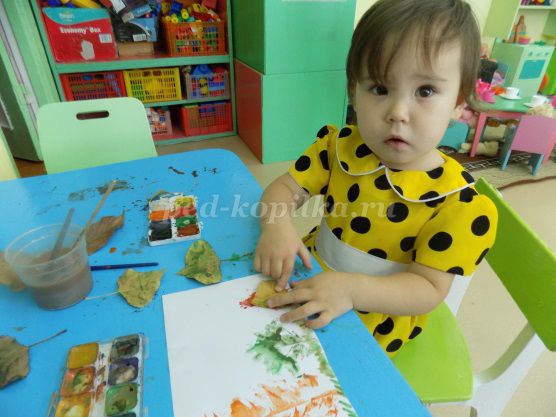
“Drawing with the palm or fingers” The child dips his palm (the entire brush) into gouache or paints it with a brush (from the age of five) and makes an imprint on paper. They draw with both the right and left hands, painted in different colors. After work, wipe your hands with a napkin, then the gouache is easily washed off.
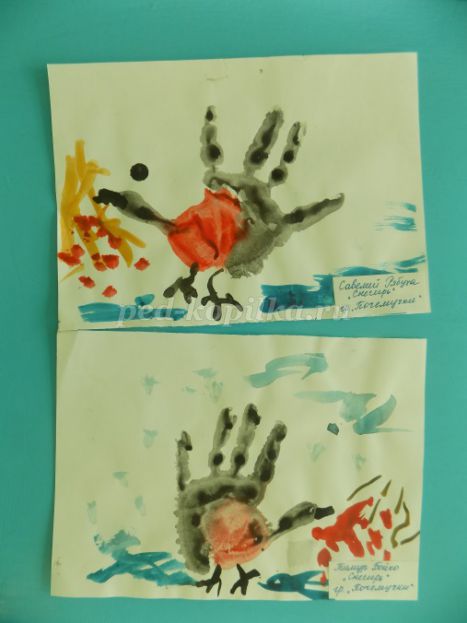
“Imprint with crumpled paper” The child crumples the paper in his hands until it becomes soft. Then he rolls it into a ball. Its dimensions may vary. After this, the child presses the crumpled paper to a stamp pad with paint and makes an impression on the paper. “Paper rolling” - take paper and crumple it in your hands until it becomes soft. Then a ball is rolled out of it. The sizes can be different (small is a berry, large is a snowman). After this, the paper ball is dipped in glue and glued to the base.
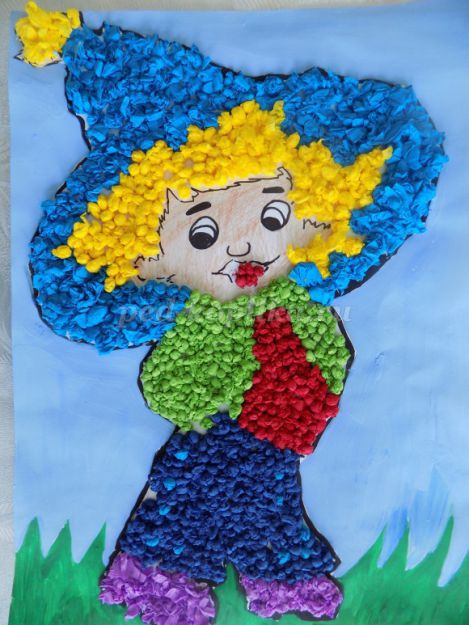
“Drawing with cotton swabs” It’s very easy to draw with cotton swabs. We dip the stick in water, then in paint and put dots on the sheet. What to draw? Whatever! The sky and the sun, a house in the village, a river, cars, dolls. The main thing in this matter is desire!
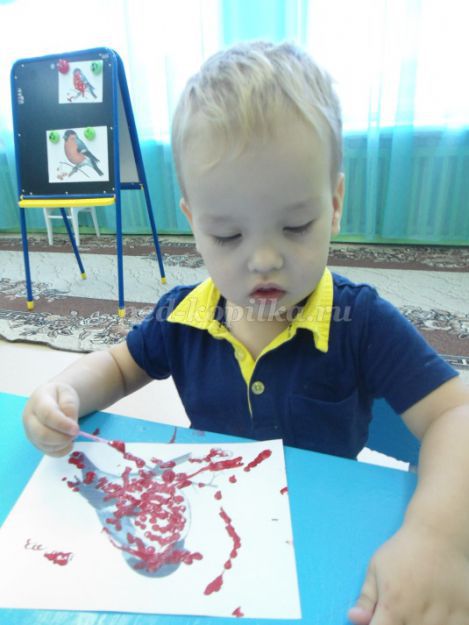
"Drawing on wet paper." The sheet is moistened with water, and then the image is applied with a brush or finger. It will turn out to be blurry in the rain or fog. If you need to draw details, you need to wait until the drawing dries or put thick paint on the brush. “Drawing with a toothbrush and disposable forks” The brush and fork are dipped in paint and an imprint is made on paper. You can drag a brush over a sheet, you will get waves, wind, stream, etc.
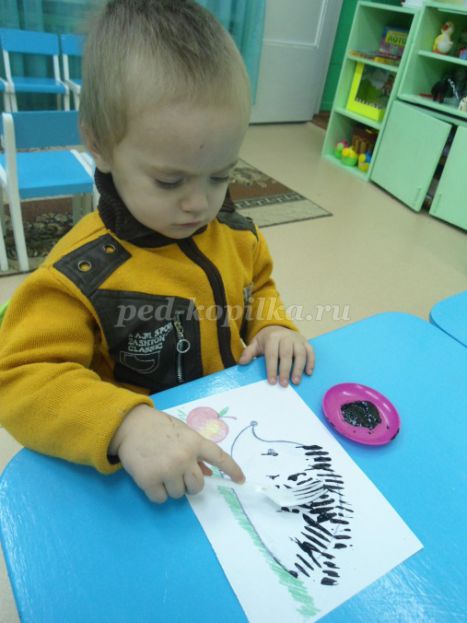
“Blotography” Blot is an integral part of every child. Therefore, this technique is very close in spirit to children. To work you need paper, a brush and paints. Paint is drawn onto the brush and dripped from a height onto the paper. By turning the sheet or blowing on it, the blot blurs, forming an interesting image.
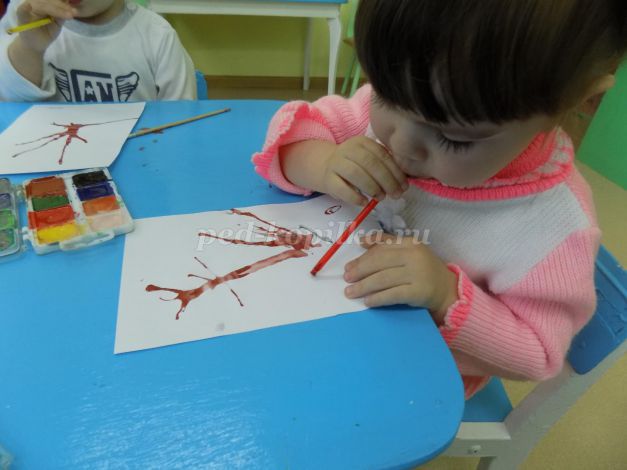
“Plasticineography” - plasticine must be heated (can be in a container with hot water). Cardboard is used, and plasticine is fixed to the surface with a pre-drawn background and outline using the technique of pressing and flattening.
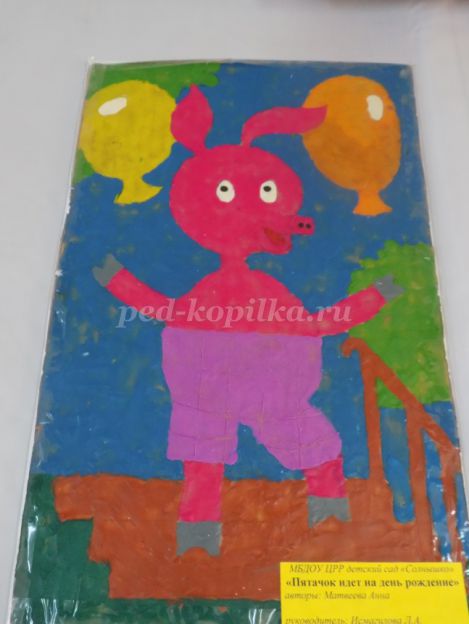
“Drawing with Soap Bubbles” Soap bubbles are a well-known children's pastime. Fragile, transparent, they shimmer so beautifully with different colors of the rainbow and create a feeling of celebration. And you can also draw with them. Drawings using this unusual technique also turn out to be very unusual, and the activity brings joy to children. Plus, the prints turn out different every time, so it's very interesting to experiment with them and then imagine what they look like.
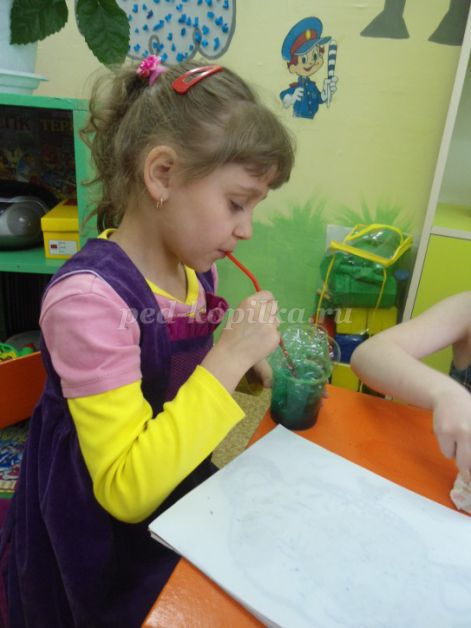
“Nitcography” There are two options for working with this technique. For each of them you will need paints with a brush, a container for them, threads and paper. In the first case, paint of any color you like is applied to the thread. The paper needs to be folded in half. The colored thread is laid out on one side, and the other is covered. The thread is then pulled out. When a child unfolds a piece of paper, there is some image there, which he can then complete at his own discretion. The second method also involves using glue. The drawing is created by gluing threads to paper in the form of a particular object.
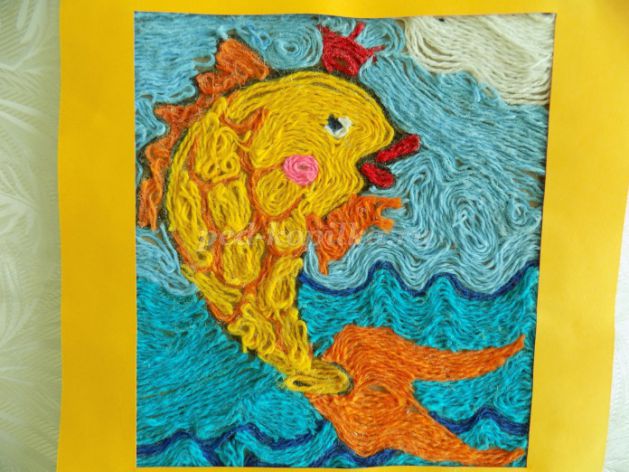
“Batik” Batik is a very old drawing technique. At the same time, the fabric is painted. The design is applied to the fabric using special paints.
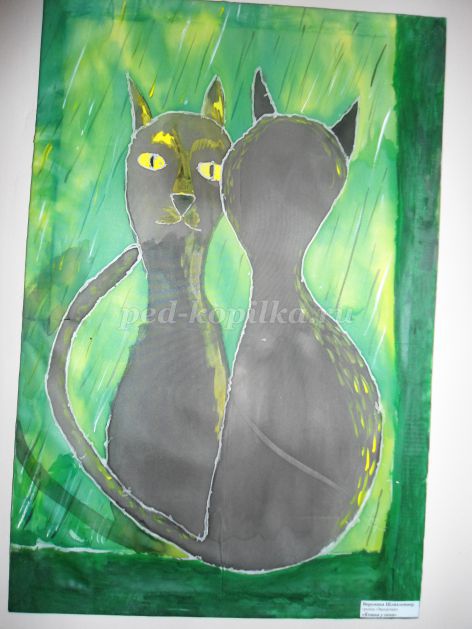
We recommend watching:
Unconventional drawing technique pointillism
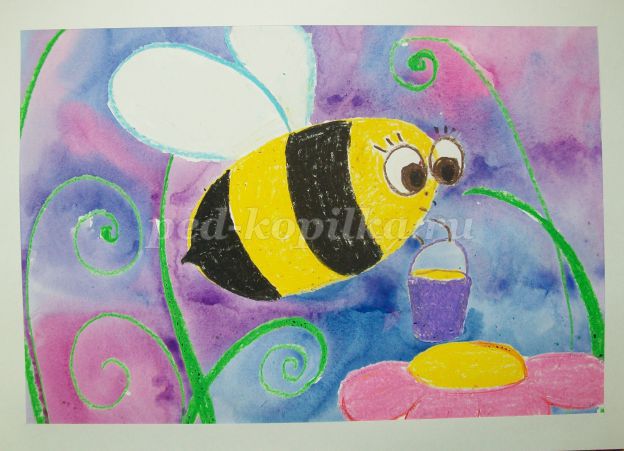
Drawing lesson in the middle group of kindergarten Drawing with a candle in kindergarten
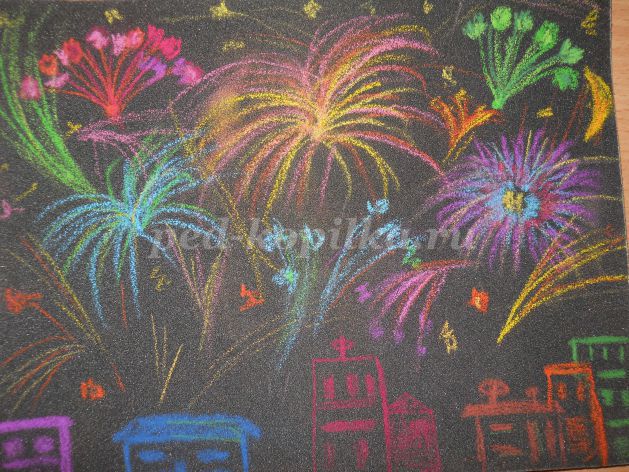
Drawing on sandpaper
Similar articles:
Fine arts lesson for the senior group
Monotype in kindergarten
Non-traditional drawing techniques in preschool educational institutions
Non-traditional drawing technique in kindergarten. Passepartout
Wax painting in kindergarten
Description of visual techniques.
Sprinkling
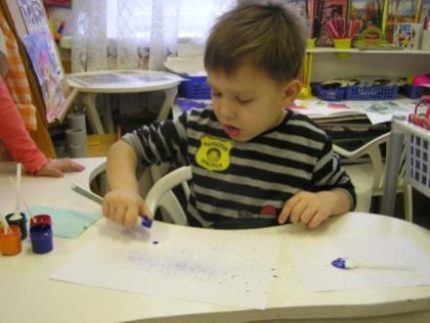
Not an easy technique. Its essence is to spray drops using a special device, which in kindergarten will be replaced by a toothbrush and a stack (a wooden stick with ends widened in the shape of a spatula). Using a toothbrush in your left hand, we will pick up a little paint, and we will move the stack along the surface of the brush - with quick movements, towards ourselves. The splashes will fly onto the paper, and maybe not only onto it... That's all.
Over time, the drops will become smaller, they will begin to lie more evenly and where they need to be. But this will happen over time, so it’s better to start mastering this technique during a walk in the summer. Now let's get to work. "A napkin for mom." Let’s “spray” it with different colors and admire the resulting effect. "Snowfall". White “spray” on different colored backgrounds. White snowflakes dance and weave into a round dance. “Golden autumn has spun.” Spray the swirling foliage with gold paint. Use a brush to draw the trunks. Material: regular comb, brush or toothbrush, paint.
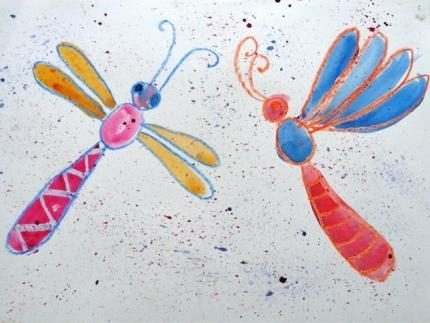
Using this method of drawing in your work, you can convey the direction of the wind - to do this, you need to try to ensure that the spray falls in the same direction throughout the entire drawing. Express seasonal changes vividly. So, for example, the leaves on the awn turn yellow and red earlier than on birch or other deciduous trees. They are yellow and green and orange on her. And the method of spraying will help to convey all this diversity. Children aged 6-7 years are engaged in spraying.
Drawing with palm, edge, fingers

Drawing technology: in the middle of the sheet the child draws with the edge of his palm, or with his palm or fingers. It is dipped in paint and imprinted on paper as necessary for the design it represents. Then the paint is wiped off with a rag. Materials: a sheet of landscape paper, sockets with gouache paint, brushes, a wet rag.

Lesson topics: “Tulips”, “Tree in summer”, “Spring tree”, “Rain”, “Mimosa”, “Edge”, “Fish”, “Rowan twig”, “A snowball is falling, falling”, “Magic butterflies”, “Festive Fireworks”, “Cheerful Palms”, “Chicken”, “Swan”, “Rabbit”, “Snail”, “Winter Tree”, “Sunshine”
Drawing with a candle

Material: paper, wax, paraffin candles, watercolors or paints. Gouache is not suitable for this method of drawing, because... does not have shine. You can use mascara.
First, the children draw with a candle everything that they want to depict on the sheet (or according to the topic). A magical drawing is obtained on the sheet, it is there, and it is not there. Then watercolor is applied to the sheet using the wash method. Depending on what you're painting, watercolor may be combined with ink. Similarly, work is performed using the “Watercolor and wax crayon” technique.
Mirror reflection

Develops imagination and creativity.
Materials: gouache of all colors, brushes, paper.
First, fold a sheet of paper in half. Then they unfold. Apply gouache stains of various sizes (at random). Then they roll it up again, run it with their hand, let the paint mix, unfold it and get anything they want, from moths to Christmas trees, from puppies to robbers. This type of drawing is very popular with children of all ages.
On crumpled paper

Painting technology: this technique is interesting because in places where the paper bends, the paint becomes more intense and dark when painted - this is called the mosaic effect. Drawing on crumpled paper is very easy. Before drawing, carefully crumple the paper, then carefully smooth it out and begin drawing.

Materials: crumpled paper, gouache paints, brushes, napkins.
Class topic: “Sea Kingdom”
Tamponation
A fun activity! Let's make a tampon from gauze (it can be replaced with a piece of foam rubber). The stamp pad will serve as a palette. Let's pick up some paints and, with light touches on the paper, we'll draw something fluffy, light, airy, and transparent.

In the younger groups - clouds, sunbeams, snowdrifts, dandelions. And it doesn’t matter that not only your heroes, but also your hands will become colored: they will wash off easily!
In the middle group, with a large swab it is very pleasant to draw fluffy chickens, funny hares, a kind snowman, bright fireflies (finishing the necessary details).

And older preschoolers can combine this technique with the “Stencil” technique in integrated classes (application and drawing). First, let's cut out the stencil. Who wants which one! Then, pressing it with your finger to a sheet of paper, we trace along the contour with light touches of the swab. Carefully lift the stencil... Miracle! Crisp and clear, it remained on paper! All the same things can be repeated in a different color and in a different place.
Painting technology: dilute watercolor paint in a saucer. Crumple the paper or plastic bag, dip it in paint and make an imprint on the paper. Then we will use a brush to complete the details of the drawing.
Materials: crumpled paper or plastic bag, watercolor paints, brushes, saucer, napkins, sheet of paper.
Lesson topics: “Spring foliage”, “Gardens have bloomed”, “Autumn foliage”, “Trees in winter”, “The owl is a wise head”, “Happy ducklings”, “Snowman”, “Winnie the Pooh and Piglet”
Monotype (obtaining an image by transferring it from one surface to another, imprinting the image)
One of the most interesting, colorful and inventive methods is monotype. To solve this, you need to have photo paper or any other paper (the higher quality the paper, the better the image), watercolor paints, soap, brushes or toothbrushes, water, glass or plastic plates. They can be of any shape and size.
The monotype technique requires the child to have developed visual skills, precision and accuracy, and the need for consistent actions. The difficulty of monotype lies in the quick creation of the drawing. Therefore, it is recommended: - at the initial stage of training, use the technique of co-creation with an adult; - the child should receive a sheet of paper with a ready-made fold line; — it is better to organize training in monotype technique with a subgroup of children.
Method of work: Watercolor is applied to a glass (plastic) base using paint, water, soap, and a brush or toothbrush. A sheet of paper is placed on top and an impression is made with your fingers, palm or swab. You can add the necessary details to the resulting image or leave the drawing as is. Frame the dried work.
Drawing with crumpled paper or plastic bag
Painting technology: dilute watercolor paint in a saucer. Crumple the paper or plastic bag, dip it in paint and make an imprint on the paper. Then we will use a brush to complete the details of the drawing.

Materials: crumpled paper or plastic bag, watercolor paints, brushes, saucer, napkins, sheet of paper.
What is needed for creativity in kindergarten?
When getting the baby ready for kindergarten, mothers often wonder: what should the child buy for creative activities? Usually in kindergartens, the teacher gives parents a standard “portfolio” to purchase - pencils, paints, brushes, sketchbooks, plasticine, colored paper, glue.
The set is, of course, understandable. But what type of plasticine should you prefer, what pencils should you buy – thick or thin, etc.? Mommy has a lot of questions like this. Let's try to highlight some of them.
For drawing
It is recommended to buy thicker pencils This diameter is much more convenient for children to hold in their hands. In addition, these pencils must be triangular. This structure will not allow the hand to strain, and the baby will learn to hold a pencil in his hand correctly. To practice drawing in kindergarten, you need colored pencils consisting of at least six primary colors. Now there is a huge selection of pencils from different manufacturers. Don’t chase beautiful packaging and don’t buy overly expensive stationery. After all, all the pencils in the kindergarten end up in a “common pot.”
The child will draw not only with pencils, but also with felt-tip pens . What little one doesn't like to run them across paper? The lines are straight, no effort is needed, the colors are bright. Isn't it beauty? When choosing felt-tip pens, give preference to those that do not have a pronounced odor, preferably water-based with the addition of food coloring. The youngest artists can draw not only on paper, but also on clothes and hands. Therefore, you should buy those that can be washed or washed easily. Many children love to open the caps on felt-tip pens. It's a pity that they just dry out quickly because of this. No problem! Buy “non-drying” triangular markers - they can remain open for a long time.
Paints are especially popular among children. Most often, gouache is used in kindergarten. It is convenient to draw on paper, it is easy to apply, does not spread, dries well, and is easily washed off your hands. It is advisable to buy a palette of 8-10 colors. The child gets acquainted with additional shades and learns to mix paints. All paints should have expiration date information on the back. Check it out as old paint doesn't mix well with water. brushes for painting: one thick, two thinner. Test them for softness. All fibers must be smooth and soft in order to draw evenly.
albums from white thick paper. Children love to draw (rub) in one place. And if the paper is thin, then the probability of a hole occurring is one hundred percent. Number of pages – at least 20 sheets.
For sculpting
You can find many materials for modeling in the store. But in kindergarten they prefer to sculpt from plasticine. There are several types of plasticine - wheat flour based, paraffin, wax, etc. It’s good when the plasticine is not greasy and kneads easily. But often this type dries out when it has been left unharvested for some time. It is not suitable for kindergarten. It’s better to buy the usual one in blocks of 6-8 colors, so that the baby can crush yesterday’s masterpiece displayed for mom and make a new one. Read on the box to ensure that the plasticine contains natural ingredients.
We make applications
For applications, children will need various papers - colored, velvet, cardboard. When buying sets, make sure that they contain at least 6 A4 colors. It is more convenient to glue with a glue stick: the child will not get dirty and will not spill it. Already in older groups, children are introduced to liquid stationery glue. To cut out for crafts, the baby will need scissors. Usually in kindergartens children in the older group are allowed to cut out parts on their own. Scissors must have rounded ends and be closed with a special housing.
